人教版(2019)必修 第二册Unit 4 History and traditions Reading and Thinking 课件-(共53张PPT)
文档属性
| 名称 | 人教版(2019)必修 第二册Unit 4 History and traditions Reading and Thinking 课件-(共53张PPT) | 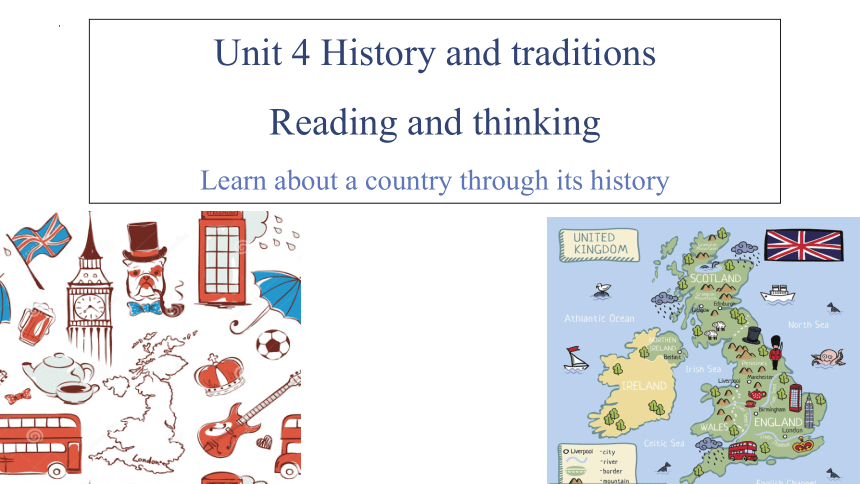 | |
| 格式 | pptx | ||
| 文件大小 | 43.6MB | ||
| 资源类型 | 教案 | ||
| 版本资源 | 人教版(2019) | ||
| 科目 | 英语 | ||
| 更新时间 | 2024-04-05 20:29:03 | ||
图片预览

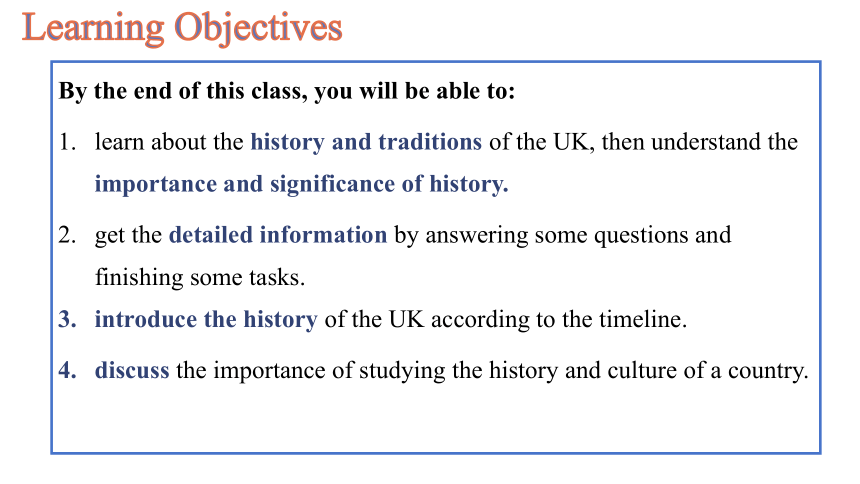

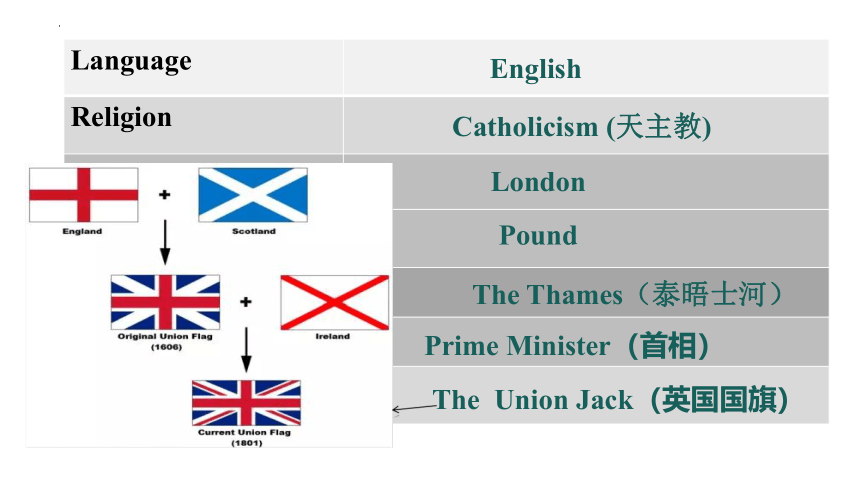

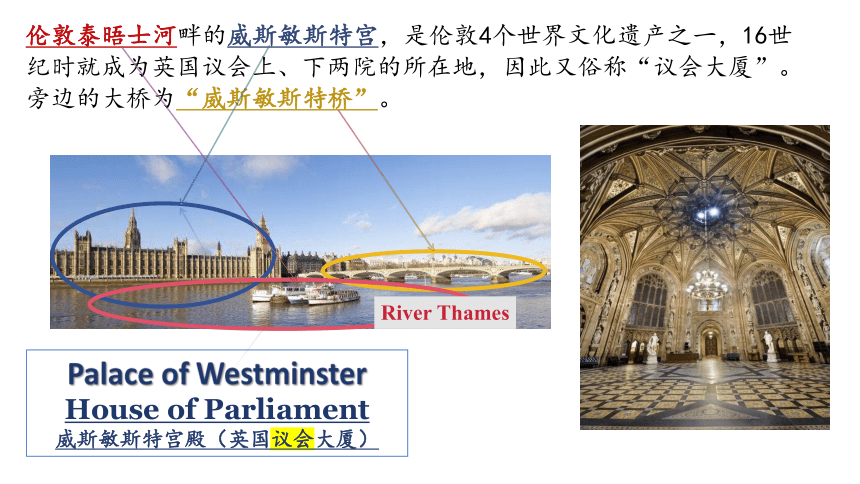
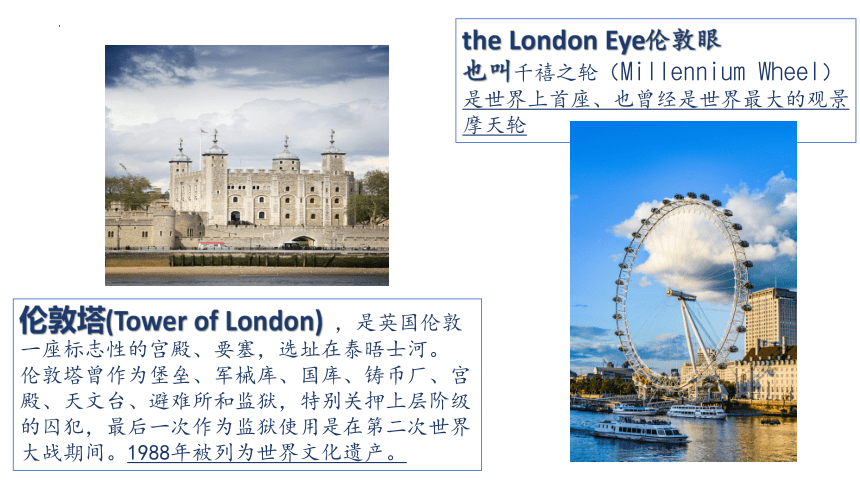

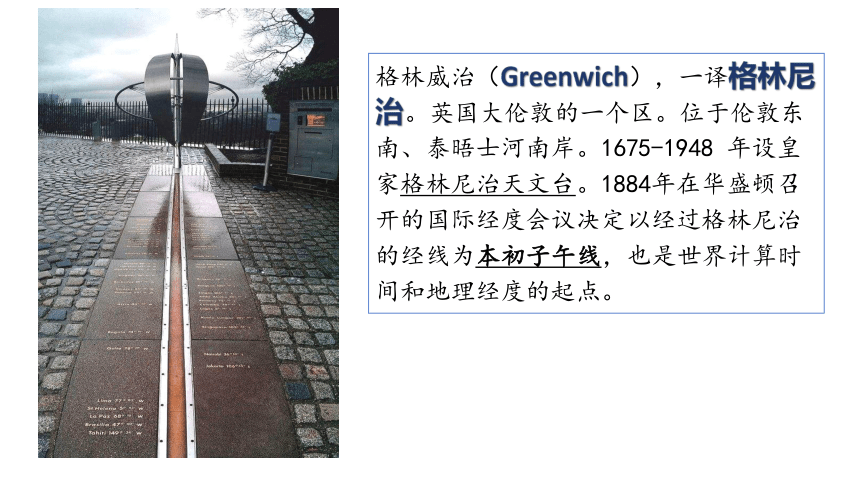
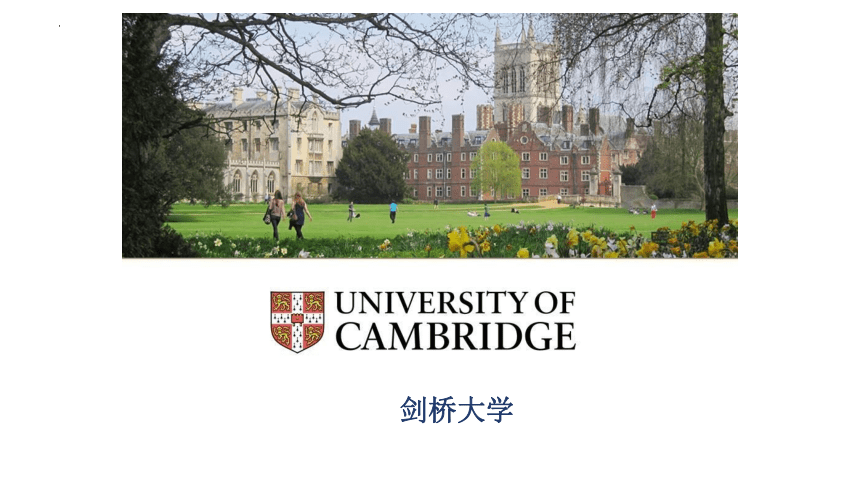
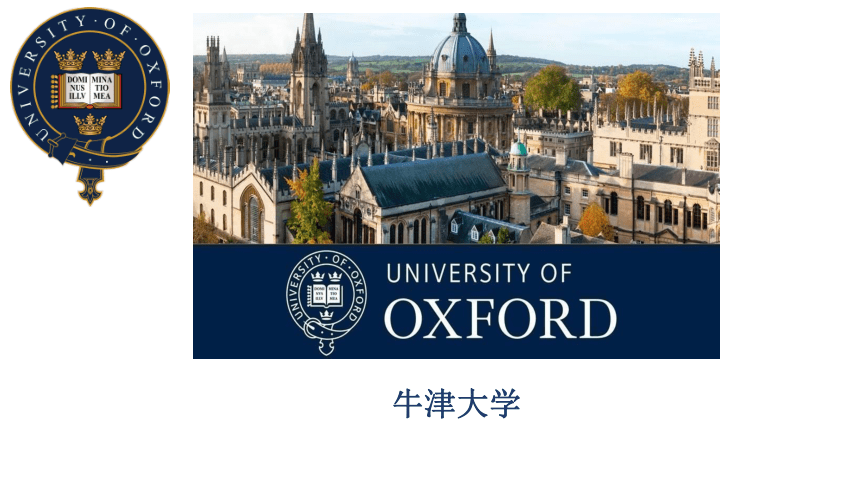
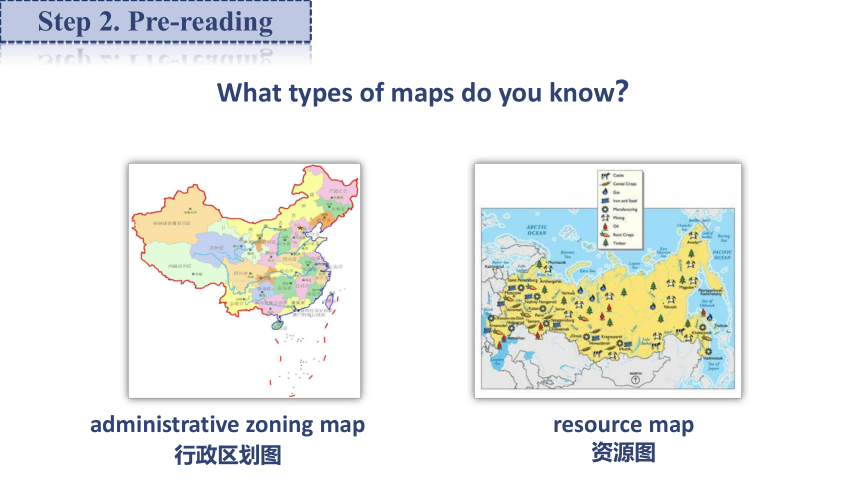
文档简介
(共53张PPT)
Unit 4 History and traditions
Reading and thinking
Learn about a country through its history
Learning Objectives
By the end of this class, you will be able to:
learn about the history and traditions of the UK, then understand the importance and significance of history.
get the detailed information by answering some questions and finishing some tasks.
introduce the history of the UK according to the timeline.
discuss the importance of studying the history and culture of a country.
quiz
2.Which is the national flag of the UK
A
B
C
1.Which is the bank note of the UK
A. Euros ?
B.U.S. Dollar
C.Pounds
the Union Jack
Language
Religion
Capital
Currency
River
Ruler
National flag
English
Catholicism (天主教)
London
Pound
The Thames(泰晤士河)
Prime Minister(首相)
The Union Jack(英国国旗)
英国女王是“临朝而不理政”,她的权力是接受磋商权、警告权和奖励权。此外,在礼仪上、形式上,女王如今仍是至高无上的,在国内、国际的国事活动中,享有荣誉和尊崇。
首相是英国实际掌权者,他能代表英国王室和民众,如中国习大大一样。此外,一般情况下,国会下议院的多数党党魁或执政联盟的首领自动成为首相人选,之后经过女王任命后正式成为首相。
女王和首相就是过去的帝王,只不过被分开了,女王继承了地位、荣誉,首相继承了权力。
伦敦泰晤士河畔的威斯敏斯特宫,是伦敦4个世界文化遗产之一,16世纪时就成为英国议会上、下两院的所在地,因此又俗称“议会大厦”。旁边的大桥为“威斯敏斯特桥”。
Palace of Westminster
House of Parliament
威斯敏斯特宫殿(英国议会大厦)
River Thames
the London Eye伦敦眼
也叫千禧之轮(Millennium Wheel)是世界上首座、也曾经是世界最大的观景摩天轮
伦敦塔(Tower of London) ,是英国伦敦一座标志性的宫殿、要塞,选址在泰晤士河。
伦敦塔曾作为堡垒、军械库、国库、铸币厂、宫殿、天文台、避难所和监狱,特别关押上层阶级的囚犯,最后一次作为监狱使用是在第二次世界大战期间。1988年被列为世界文化遗产。
伊丽莎白塔(Elizabeth Tower),旧称大本钟(Big Ben),即威斯敏斯特宫钟塔,伊丽莎白塔于1858年4月10日建成,是英国最大的钟。世界上著名的哥特式建筑之一,伦敦的标志性建筑。2012年6月,英国宣布把伦敦著名地标“大本钟”的钟楼改名为“伊丽莎白塔”。
格林威治(Greenwich),一译格林尼治。英国大伦敦的一个区。位于伦敦东南、泰晤士河南岸。1675-1948 年设皇家格林尼治天文台。1884年在华盛顿召开的国际经度会议决定以经过格林尼治的经线为本初子午线,也是世界计算时间和地理经度的起点。
剑桥大学
牛津大学
administrative zoning map
行政区划图
resource map
资源图
What types of maps do you know?
Step 2. Pre-reading
traffic map
交通图
weather map
气象图
topographic map
地形图
[,t p 'ɡr f k]
What types of maps do you know?
What type of map is it
A. traffic map
B. weather map
C. resource map
D. administrative zoning map
E. topographic map
Question : What’s the real name of “Ying Guo”
Watch a short video and answer the following questions.
1. This is a map of ___________________.
2. How many colors in this map
3. Each color stands for one country, what are they
Watch a short video and answer the following questions.
1. This is a map of ___________________.
2. How many colors in this map
3. Each color stands for one country, what are they
the United Kingdom
Four
England Scotland Wales Northern Ireland
Why does the UK consist of the four countries
What’s in a name
To arouse readers' interest in the text and continue to read it.
PUZZLE !
Why does the writer use a question as the title
What’s in a name
From the title, we can know that the article mainly talks about_______________________________________
_________________________________.
the name’s changes of the UK, and it may
be about the development of history
What's the main idea of the passage
A. The history of the United Kingdom.
B. The geography of the United Kingdom.
C. The people of the United Kingdom.
D. The politics of the United Kingdom.
√
Prediction
Skim the text and match each paragraph with its main idea.
Para. 1 A. Four groups of people in UK’s history
Para. 2 B. The four names of the country
Para. 3 C.
Para. 4 D.
Para. 5 E. A puzzle concerning the name
The similarities and differences among the four countries within the UK
The importance of studying history
History and
Traditions
Part1 (Para.1-2)
Part3 (Para.4-5)
Part2 (Para.3)
The origin of the name of the UK.
The history, traditions and culture of the United Kingdom.
The four countries work together in some areas.
What is the genre(语篇类型) of the text
A. Narration B. Argumentation C. Exposition
(叙述文) (议论文) (说明文)
Task 3:Divide the text into three parts.
Q1: How many names are used to refer to the UK and what are they?
Q2: What does the author suggest to solve this puzzle?
Para.1
--------to introduce the topic by raising a puzzle
to arouse(激起) interest of the readers
A puzzle
While-reading
Q3:What is the full name of UK
Q4: What are people from the UK called
British.
Para.2 History
the United Kingdom of GreatBritain and Northern Ireland
In the 16th century, the nearby country of Wales was joined to the Kingdom of England. Later, in the 18th century, the country Scotland was joined to create the Kingdom of Great Britain. In the 19th century, the Kingdom of Ireland was added to create the United Kingdom of Great Britain and Ireland. Finally, in the 20th century, the southern part of Ireland broke away from the UK, which resulted in the full name we have today: the United Kingdom of Great Britain and Northern Ireland. Most people just use the shortened name:“the United Kingdom” or “the UK”. People from the UK are called “British”, which means the UK is also often referred to as Britain or Great Britain.
What method does the writer use in this passage to illustrate(talk about) his thought
sequence of time
(时间顺序法)
2. Scan Para 2 and circle the words that describe time.
1. In what order is this paragraph organized
Para 2
How did the UK formed in the ____century _________ was joined to the kingdom of England.
in the_____century __________ was joined to create the kingdom of Great Britain.
in the ____ century The kingdom of _______ was added to create the United Kingdom of Great Britain and Ireland.
in the ___ century _____________________ broke away from the UK, which resulted in the full name: the United Kingdom of Great Britain and Northern Ireland.
Wales
Scotland
19th
18th
16th
Ireland
20th
The southern part of Ireland
Fill in the blanks according to Para.1&Para.2
Similarities _____; _________; ________________
Differences ___________ and _____ systems; __________________ and even ______________ for competitions.
currency
flag
military defence
educational
legal
their own traditions
football teams
Para.3 Similarities and differences
How does the author develop paragraph 3
A.By expressing some personal opinions B.By using a couple of quotes
C.By referring to a social phenomenon
D.By making some comparisons
Quiz
Peoples
The Romans
The Anglo-Saxons
The Vikings
The Normans
Time
in 1st century
in 5th century
in 8th century
in 11th century
Building towns and roads
Introducing English, changing the way people built houses
Achievements
Leaving behind lots of new vocabulary and location names
Having castles built, changing legal system, introducing French into English
Para 4
(3mins)
Four different groups of people who took over the UK in turn throughout history and their influence on the history of the UK.
Para.4 People and traditions
Q7: Is there anything else we can benefit from studying the history of the UK
Q8: Why is London said to be a great place to start
Q9: What impression is given of the UK Any supporting words
Para.5 Trip
What’s the author’s attitude towards studying the history
Neutral
Indifferent
C. Favorable
D. Doubtful
Quiz
○
If you keep your eyes open, you will be surprised to find that you can see both its past and its present.
Q1 : Who does the word “you” refer to
A. scientists B. visitors
C. parents D. exchange students
Q2 : What’s the writing purpose of writing this passage
A. to introduce the history of the UK for visitors
B. to share his travel experience with others
C. to tell us how to travel around the world
D. to show how travel can change the world
Try to draw a mind map according to the whole passage.
1st century
5th century
8th century
11th century
16th century
18th century
19th century
20th century
Summary
20th century
11th century
16th century
18th century
19th century
Romans arrived
Anglo-Saxons came
Vikings came
1st century
5th century
8th century
Normans conquered
Wales was joined
Scotland was joined
Ireland was added
Southern Ireland broke away
Timeline
the Anglo-Saxons
the Vikings
Sort out the information according to the timeline (P41)
When What happened What changed
Romans arrived
Ango-Saxons came
Vikings came
11th century
1st century
5th century
8th century
Normans conquered England after the Battle of Hastings
towns and roads
language and way houses were built
vocabulary and names of locations across the UK
castles built, legal system changed, and new words from French introduced
Post-reading
Sort out the information according to the timeline. (P41)
When What happened What changed
16th century
18th century
19th century
20th century
Wales was joined to Kingdom of England
Scotland was joined to England and Wales
Ireland was added
the southern part of Ireland broke away
“Kingdom of Great Britain” formed
“United Kingdom of Great Britain and Ireland” formed
name changed to “United Kingdom of Great Britain and Northern Ireland”
Read the text carefully and fill in the blanks
WHAT'S IN A NAME
The United Kingdom, Great Britain, Britain, England--many people ___________ by what these different names mean. So ________is the difference between them, if any _________ (get) to know a little bit about British history will help you solve this puzzle.
In the 16th century, the nearby country of Wales was joined to the Kingdom of England. Later, in the 18th century, the country Scotland was joined _________ (create) the Kingdom of Great Britain. In the 19th century, the Kingdom of lreland __________(add) to create the United Kingdom of Great Britain and Ireland.
are confused
what
Getting
to create
was added
Summary
Finally, in the 20th century, the southern part of lreland broke away _______ the UK , ________ resulted in the full name we have today: the United Kingdom of Great Britain and Northern Ireland. Most people just use the _________(short) name: "the United Kingdom" or "the UK". People from the UK _________(call) "British” which means the UK is also often referred to ____ Britain or Great Britain.
The four countries__________belong to the United Kingdom work together in some areas. They use ____same flag, ________(know) as the Union Jack, as well as share the same currency and military defence. However, they also have some __________(different). For example, England, Wales Scotland,andNorthernIreland all have different education systems and legal systems .
from
which
as
shortened
are called
that/which
the
known
differences
Summary
They also have their own _________(tradition), like their own national days and national dishes. And they even have their own football teams for _____________(compete) like the World Cup!
The United Kingdom has a long and interesting history __________ (explore), ______can help you derstand much more about the country and its traditions. Almost everywhere you go in the UK ,you will __________ (surround) by evidence of four different groups of people _____took over at different times throughout history. The first group, the Romans, came in the first century.Some of their great ____________(achievement) included ________(build) towns and roads.
traditions
to explore
which
competitions
be surrounded
who
achievements
building
Summary
Next, the Anglo-Saxons arrived in the ______(five) century. They introduced the beginnings of the English language,and ________(change) the way people built houses. The Vikings came in the eighth century, left behind lots of new vocabulary, and also the names of many locations across the UK. The last group ______(be) the Normans. They conquered England after the well-known Battle of Hastings in the11th century. They had castles ______(build) all around England, and made changes to the legal system. The Normans were French, so many French words _______ (slow) entered into the English language.There is so much more to learn about the interesting history ______culture of the United Kingdom.
changed
fifth
were
built
slowly
and
Summary
________ the history of the country will make your visit much more _________(enjoy). The capital city London is a great place _______ (start), as it is an ancient port city ____________ has a history _______(date) all the way back___Roman times.There are countless historic sites __________ (explore), and lots of museums with ancient relics from all over the UK. The UK is a ___________(fascinate) mix of history and modern culture, with both new and old traditions. lf you keep your eyes open, you will be ________(surprise) to find that you can see both its past and its present.
Studying
enjoyable
to start
that/which
dating
to
to explore
fascinating
surprised
Summary
WHAT’S IN A NAME
The United Kingdom
Great Britain
Britain
England
In a name, there is _________________.
a history
the United Kingdom of Great Britain and Northern Ireland
1
4
2
3
Further Thinking
也;还;和
属于
加入
把...和..连接起来
叛背;逃脱;背离
留心;注意
as well as
belong to
joined to
added to
broke away
keep your eyes open
(书P41)
1.Is it necessary for visitors to study the history and culture of a country before visiting it Why
Step 4. Discussion
Debate
I think so.
Studying a country’s history and culture
1. will help you understand the place better;
2. will have a more enjoyable experience;
3. will be able to interact better with the people
4. will have a richer experience.
I don’t think so.
1. The travel will be more adventurous and exciting;
2. We can learn them during our visits.
Is it necessary for visitors to study the history and culture of a country before visiting it Why
1.So what is the difference between them, if any
所以如果有区别的话,区别是什么呢?
if necessary 如果有必要的话
if possible 如果可能的话
if not 如果不是的话 if so 如果是这样的话
if ever 如果有过/发生过的话
重点结构:“if+any”的省略结构,是if there is/are any at all的省略形式,起加强语气的作用。
Language Points
Will you get a free evening next week , let’s have a dinner.
Is everybody feeling cold , let’s open the window.
, you can turn to me for help.
Please try to find out the differences between the two words. , speak it out.
If so
If not
If necessary
If any
2.They had castles built all around England, and made changes to the legal system.
(1)“have+sth. (宾语)+过去分词 说明宾语与过去分词表示的动作之间是被动关系。
(2)have sb. do sth. 让某人做某事(一次性动作)
(3)have sb./sth. doing 让某人一直在做某事/让某事一直发生
(4)have sth. to do 有某事要做(动作未完成)
I will have my room ___________ (decorate)this summer because it is a bit old.
decorated
单句语法填空
①I fell down and broke three of my teeth. I wonder how many times I have to come here and have my false teeth _____ (fix).
②I won't have you ________ (make)the same mistake again and again.
③When his mother had him do his homework, he decided to have his light __________ (burn) all night to pretend he was working hard.
④I have a lot of readings _____________(complete) before the end of this term.
fixed
making
to complete
burning
关于英国有趣的历史和文化,还有更多的东西需要学习。
研究国家的历史将使你的旅行更加愉快。
首都伦敦是一个很好的起点,因为它是一个古老的港口城市,其历史可以追溯到古罗马时代。
这里有数不胜数的历史遗迹可供探索,还有许多的博物馆,博物馆里收藏着来自英国各地的古代文物。
英国是历史与现代文化的完美结合,既有新传统也有旧传统。
如果你留心观察,你会惊讶地发现你既可以看到它的过去,也可以看到它的现在。
Task 4 课文背诵 第 5 段
Video Time
Unit 4 History and traditions
Reading and thinking
Learn about a country through its history
Learning Objectives
By the end of this class, you will be able to:
learn about the history and traditions of the UK, then understand the importance and significance of history.
get the detailed information by answering some questions and finishing some tasks.
introduce the history of the UK according to the timeline.
discuss the importance of studying the history and culture of a country.
quiz
2.Which is the national flag of the UK
A
B
C
1.Which is the bank note of the UK
A. Euros ?
B.U.S. Dollar
C.Pounds
the Union Jack
Language
Religion
Capital
Currency
River
Ruler
National flag
English
Catholicism (天主教)
London
Pound
The Thames(泰晤士河)
Prime Minister(首相)
The Union Jack(英国国旗)
英国女王是“临朝而不理政”,她的权力是接受磋商权、警告权和奖励权。此外,在礼仪上、形式上,女王如今仍是至高无上的,在国内、国际的国事活动中,享有荣誉和尊崇。
首相是英国实际掌权者,他能代表英国王室和民众,如中国习大大一样。此外,一般情况下,国会下议院的多数党党魁或执政联盟的首领自动成为首相人选,之后经过女王任命后正式成为首相。
女王和首相就是过去的帝王,只不过被分开了,女王继承了地位、荣誉,首相继承了权力。
伦敦泰晤士河畔的威斯敏斯特宫,是伦敦4个世界文化遗产之一,16世纪时就成为英国议会上、下两院的所在地,因此又俗称“议会大厦”。旁边的大桥为“威斯敏斯特桥”。
Palace of Westminster
House of Parliament
威斯敏斯特宫殿(英国议会大厦)
River Thames
the London Eye伦敦眼
也叫千禧之轮(Millennium Wheel)是世界上首座、也曾经是世界最大的观景摩天轮
伦敦塔(Tower of London) ,是英国伦敦一座标志性的宫殿、要塞,选址在泰晤士河。
伦敦塔曾作为堡垒、军械库、国库、铸币厂、宫殿、天文台、避难所和监狱,特别关押上层阶级的囚犯,最后一次作为监狱使用是在第二次世界大战期间。1988年被列为世界文化遗产。
伊丽莎白塔(Elizabeth Tower),旧称大本钟(Big Ben),即威斯敏斯特宫钟塔,伊丽莎白塔于1858年4月10日建成,是英国最大的钟。世界上著名的哥特式建筑之一,伦敦的标志性建筑。2012年6月,英国宣布把伦敦著名地标“大本钟”的钟楼改名为“伊丽莎白塔”。
格林威治(Greenwich),一译格林尼治。英国大伦敦的一个区。位于伦敦东南、泰晤士河南岸。1675-1948 年设皇家格林尼治天文台。1884年在华盛顿召开的国际经度会议决定以经过格林尼治的经线为本初子午线,也是世界计算时间和地理经度的起点。
剑桥大学
牛津大学
administrative zoning map
行政区划图
resource map
资源图
What types of maps do you know?
Step 2. Pre-reading
traffic map
交通图
weather map
气象图
topographic map
地形图
[,t p 'ɡr f k]
What types of maps do you know?
What type of map is it
A. traffic map
B. weather map
C. resource map
D. administrative zoning map
E. topographic map
Question : What’s the real name of “Ying Guo”
Watch a short video and answer the following questions.
1. This is a map of ___________________.
2. How many colors in this map
3. Each color stands for one country, what are they
Watch a short video and answer the following questions.
1. This is a map of ___________________.
2. How many colors in this map
3. Each color stands for one country, what are they
the United Kingdom
Four
England Scotland Wales Northern Ireland
Why does the UK consist of the four countries
What’s in a name
To arouse readers' interest in the text and continue to read it.
PUZZLE !
Why does the writer use a question as the title
What’s in a name
From the title, we can know that the article mainly talks about_______________________________________
_________________________________.
the name’s changes of the UK, and it may
be about the development of history
What's the main idea of the passage
A. The history of the United Kingdom.
B. The geography of the United Kingdom.
C. The people of the United Kingdom.
D. The politics of the United Kingdom.
√
Prediction
Skim the text and match each paragraph with its main idea.
Para. 1 A. Four groups of people in UK’s history
Para. 2 B. The four names of the country
Para. 3 C.
Para. 4 D.
Para. 5 E. A puzzle concerning the name
The similarities and differences among the four countries within the UK
The importance of studying history
History and
Traditions
Part1 (Para.1-2)
Part3 (Para.4-5)
Part2 (Para.3)
The origin of the name of the UK.
The history, traditions and culture of the United Kingdom.
The four countries work together in some areas.
What is the genre(语篇类型) of the text
A. Narration B. Argumentation C. Exposition
(叙述文) (议论文) (说明文)
Task 3:Divide the text into three parts.
Q1: How many names are used to refer to the UK and what are they?
Q2: What does the author suggest to solve this puzzle?
Para.1
--------to introduce the topic by raising a puzzle
to arouse(激起) interest of the readers
A puzzle
While-reading
Q3:What is the full name of UK
Q4: What are people from the UK called
British.
Para.2 History
the United Kingdom of GreatBritain and Northern Ireland
In the 16th century, the nearby country of Wales was joined to the Kingdom of England. Later, in the 18th century, the country Scotland was joined to create the Kingdom of Great Britain. In the 19th century, the Kingdom of Ireland was added to create the United Kingdom of Great Britain and Ireland. Finally, in the 20th century, the southern part of Ireland broke away from the UK, which resulted in the full name we have today: the United Kingdom of Great Britain and Northern Ireland. Most people just use the shortened name:“the United Kingdom” or “the UK”. People from the UK are called “British”, which means the UK is also often referred to as Britain or Great Britain.
What method does the writer use in this passage to illustrate(talk about) his thought
sequence of time
(时间顺序法)
2. Scan Para 2 and circle the words that describe time.
1. In what order is this paragraph organized
Para 2
How did the UK formed in the ____century _________ was joined to the kingdom of England.
in the_____century __________ was joined to create the kingdom of Great Britain.
in the ____ century The kingdom of _______ was added to create the United Kingdom of Great Britain and Ireland.
in the ___ century _____________________ broke away from the UK, which resulted in the full name: the United Kingdom of Great Britain and Northern Ireland.
Wales
Scotland
19th
18th
16th
Ireland
20th
The southern part of Ireland
Fill in the blanks according to Para.1&Para.2
Similarities _____; _________; ________________
Differences ___________ and _____ systems; __________________ and even ______________ for competitions.
currency
flag
military defence
educational
legal
their own traditions
football teams
Para.3 Similarities and differences
How does the author develop paragraph 3
A.By expressing some personal opinions B.By using a couple of quotes
C.By referring to a social phenomenon
D.By making some comparisons
Quiz
Peoples
The Romans
The Anglo-Saxons
The Vikings
The Normans
Time
in 1st century
in 5th century
in 8th century
in 11th century
Building towns and roads
Introducing English, changing the way people built houses
Achievements
Leaving behind lots of new vocabulary and location names
Having castles built, changing legal system, introducing French into English
Para 4
(3mins)
Four different groups of people who took over the UK in turn throughout history and their influence on the history of the UK.
Para.4 People and traditions
Q7: Is there anything else we can benefit from studying the history of the UK
Q8: Why is London said to be a great place to start
Q9: What impression is given of the UK Any supporting words
Para.5 Trip
What’s the author’s attitude towards studying the history
Neutral
Indifferent
C. Favorable
D. Doubtful
Quiz
○
If you keep your eyes open, you will be surprised to find that you can see both its past and its present.
Q1 : Who does the word “you” refer to
A. scientists B. visitors
C. parents D. exchange students
Q2 : What’s the writing purpose of writing this passage
A. to introduce the history of the UK for visitors
B. to share his travel experience with others
C. to tell us how to travel around the world
D. to show how travel can change the world
Try to draw a mind map according to the whole passage.
1st century
5th century
8th century
11th century
16th century
18th century
19th century
20th century
Summary
20th century
11th century
16th century
18th century
19th century
Romans arrived
Anglo-Saxons came
Vikings came
1st century
5th century
8th century
Normans conquered
Wales was joined
Scotland was joined
Ireland was added
Southern Ireland broke away
Timeline
the Anglo-Saxons
the Vikings
Sort out the information according to the timeline (P41)
When What happened What changed
Romans arrived
Ango-Saxons came
Vikings came
11th century
1st century
5th century
8th century
Normans conquered England after the Battle of Hastings
towns and roads
language and way houses were built
vocabulary and names of locations across the UK
castles built, legal system changed, and new words from French introduced
Post-reading
Sort out the information according to the timeline. (P41)
When What happened What changed
16th century
18th century
19th century
20th century
Wales was joined to Kingdom of England
Scotland was joined to England and Wales
Ireland was added
the southern part of Ireland broke away
“Kingdom of Great Britain” formed
“United Kingdom of Great Britain and Ireland” formed
name changed to “United Kingdom of Great Britain and Northern Ireland”
Read the text carefully and fill in the blanks
WHAT'S IN A NAME
The United Kingdom, Great Britain, Britain, England--many people ___________ by what these different names mean. So ________is the difference between them, if any _________ (get) to know a little bit about British history will help you solve this puzzle.
In the 16th century, the nearby country of Wales was joined to the Kingdom of England. Later, in the 18th century, the country Scotland was joined _________ (create) the Kingdom of Great Britain. In the 19th century, the Kingdom of lreland __________(add) to create the United Kingdom of Great Britain and Ireland.
are confused
what
Getting
to create
was added
Summary
Finally, in the 20th century, the southern part of lreland broke away _______ the UK , ________ resulted in the full name we have today: the United Kingdom of Great Britain and Northern Ireland. Most people just use the _________(short) name: "the United Kingdom" or "the UK". People from the UK _________(call) "British” which means the UK is also often referred to ____ Britain or Great Britain.
The four countries__________belong to the United Kingdom work together in some areas. They use ____same flag, ________(know) as the Union Jack, as well as share the same currency and military defence. However, they also have some __________(different). For example, England, Wales Scotland,andNorthernIreland all have different education systems and legal systems .
from
which
as
shortened
are called
that/which
the
known
differences
Summary
They also have their own _________(tradition), like their own national days and national dishes. And they even have their own football teams for _____________(compete) like the World Cup!
The United Kingdom has a long and interesting history __________ (explore), ______can help you derstand much more about the country and its traditions. Almost everywhere you go in the UK ,you will __________ (surround) by evidence of four different groups of people _____took over at different times throughout history. The first group, the Romans, came in the first century.Some of their great ____________(achievement) included ________(build) towns and roads.
traditions
to explore
which
competitions
be surrounded
who
achievements
building
Summary
Next, the Anglo-Saxons arrived in the ______(five) century. They introduced the beginnings of the English language,and ________(change) the way people built houses. The Vikings came in the eighth century, left behind lots of new vocabulary, and also the names of many locations across the UK. The last group ______(be) the Normans. They conquered England after the well-known Battle of Hastings in the11th century. They had castles ______(build) all around England, and made changes to the legal system. The Normans were French, so many French words _______ (slow) entered into the English language.There is so much more to learn about the interesting history ______culture of the United Kingdom.
changed
fifth
were
built
slowly
and
Summary
________ the history of the country will make your visit much more _________(enjoy). The capital city London is a great place _______ (start), as it is an ancient port city ____________ has a history _______(date) all the way back___Roman times.There are countless historic sites __________ (explore), and lots of museums with ancient relics from all over the UK. The UK is a ___________(fascinate) mix of history and modern culture, with both new and old traditions. lf you keep your eyes open, you will be ________(surprise) to find that you can see both its past and its present.
Studying
enjoyable
to start
that/which
dating
to
to explore
fascinating
surprised
Summary
WHAT’S IN A NAME
The United Kingdom
Great Britain
Britain
England
In a name, there is _________________.
a history
the United Kingdom of Great Britain and Northern Ireland
1
4
2
3
Further Thinking
也;还;和
属于
加入
把...和..连接起来
叛背;逃脱;背离
留心;注意
as well as
belong to
joined to
added to
broke away
keep your eyes open
(书P41)
1.Is it necessary for visitors to study the history and culture of a country before visiting it Why
Step 4. Discussion
Debate
I think so.
Studying a country’s history and culture
1. will help you understand the place better;
2. will have a more enjoyable experience;
3. will be able to interact better with the people
4. will have a richer experience.
I don’t think so.
1. The travel will be more adventurous and exciting;
2. We can learn them during our visits.
Is it necessary for visitors to study the history and culture of a country before visiting it Why
1.So what is the difference between them, if any
所以如果有区别的话,区别是什么呢?
if necessary 如果有必要的话
if possible 如果可能的话
if not 如果不是的话 if so 如果是这样的话
if ever 如果有过/发生过的话
重点结构:“if+any”的省略结构,是if there is/are any at all的省略形式,起加强语气的作用。
Language Points
Will you get a free evening next week , let’s have a dinner.
Is everybody feeling cold , let’s open the window.
, you can turn to me for help.
Please try to find out the differences between the two words. , speak it out.
If so
If not
If necessary
If any
2.They had castles built all around England, and made changes to the legal system.
(1)“have+sth. (宾语)+过去分词 说明宾语与过去分词表示的动作之间是被动关系。
(2)have sb. do sth. 让某人做某事(一次性动作)
(3)have sb./sth. doing 让某人一直在做某事/让某事一直发生
(4)have sth. to do 有某事要做(动作未完成)
I will have my room ___________ (decorate)this summer because it is a bit old.
decorated
单句语法填空
①I fell down and broke three of my teeth. I wonder how many times I have to come here and have my false teeth _____ (fix).
②I won't have you ________ (make)the same mistake again and again.
③When his mother had him do his homework, he decided to have his light __________ (burn) all night to pretend he was working hard.
④I have a lot of readings _____________(complete) before the end of this term.
fixed
making
to complete
burning
关于英国有趣的历史和文化,还有更多的东西需要学习。
研究国家的历史将使你的旅行更加愉快。
首都伦敦是一个很好的起点,因为它是一个古老的港口城市,其历史可以追溯到古罗马时代。
这里有数不胜数的历史遗迹可供探索,还有许多的博物馆,博物馆里收藏着来自英国各地的古代文物。
英国是历史与现代文化的完美结合,既有新传统也有旧传统。
如果你留心观察,你会惊讶地发现你既可以看到它的过去,也可以看到它的现在。
Task 4 课文背诵 第 5 段
Video Time
